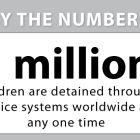
Opinion: Lead Exposure’s Link to Crime Should Shape Criminal Sentencing, Early Release
|
Pure Earth and UNICEF reported in 2020 that, globally, one out of three children are exposed to dangerous levels of lead, a poison that gets into the bloodstream, then impairs the brain and the body in many ways.
The United States has made great progress toward reducing lead exposure from gasoline and paint. But more work is needed to protect all American children, including those whose exposure to lead during early childhood — and even while in their mother’s womb — has been linked to behaviors landing them in the juvenile justice system.
